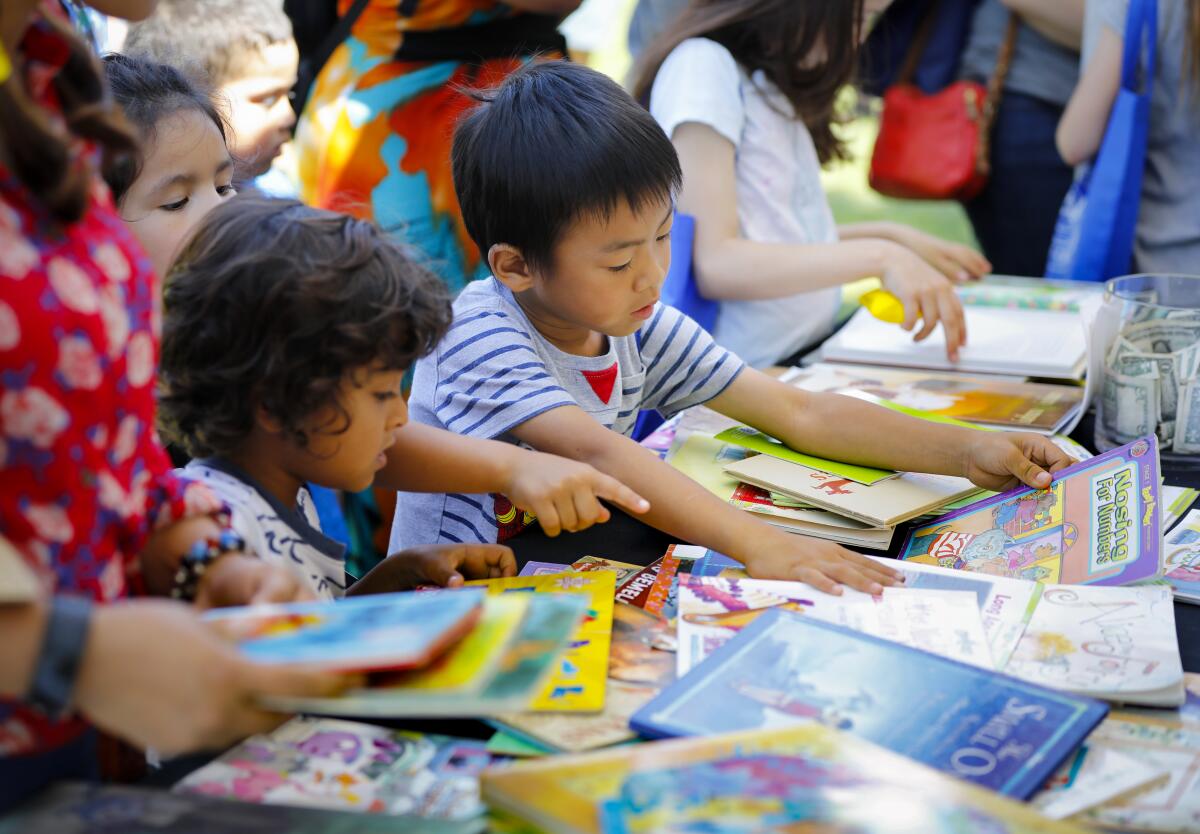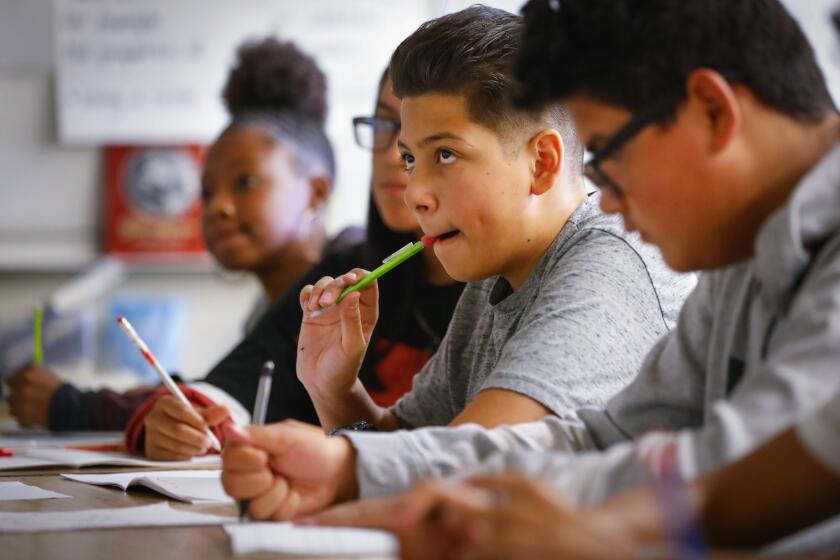Fewer kids read for fun anymore. They’re losing out on more than great stories

- Share via
It was Harry Potter — or, actually, his buddy Hermione Granger — who made my 6-year-old granddaughter enthusiastic about learning to read.
She was reasonably interested in reading before that, though remote learning during most of her kindergarten year means she and all the other first-graders at her small charter school along the central coast of California aren’t at the pre-pandemic levels of literacy for their age. Then, as my daughter began reading the J.K. Rowling books to her, my granddaughter discovered the girl witch and now is obsessed with books.
Hermione frequents the Hogwarts library and, just for the pleasure of it, absorbs the information within its books. More often than not, that information saves the day for her and her friends. My granddaughter wants to be a heroic brainiac just like Hermione. She knows that means unlocking the codes of reading.
A Guide to Storytime is Reading by 9’s annual bilingual reading guide for parents and educators.
Of course, she was probably destined to become a lover of reading. Her parents both have doctorates in English literature. My daughter probably got much of her love of reading from me. I got it from my father, who dropped out of high school to support his parents and siblings during the Great Depression, but who nonetheless made weekly trips to the library throughout his life to borrow a stack of books that he would devour. Family background aside, almost any student can love reading and begin their own family tradition.
As a mother who had three kids in public schools, it always bugged me that the elementary school had a voluntary “reading club” in which students received prizes based on how much reading for pleasure they did each week. The message seems all wrong: We have to bribe you to read for fun.
All this comes to mind now that a survey by the National Assessment for Educational Progress — the organization that produces the periodic Nation’s Report Card based on student testing — found that the numbers of 9- and 13-year-olds who regularly read for pleasure had plummeted.
Editorial: Kids aren’t making progress on national tests — and that’s from before the pandemic
Test scores of 13-year-olds actually fell for the first time. The results show that the nation is not zeroing in on effective reforms for learning.
Elementary school children are more likely to read than their older counterparts, according to the survey But still, the number of 9-year-olds who say they read for enjoyment almost every day dropped from slightly more than half in 1984, to 42% during the 2019-20 school year. The trend among middle schoolers is worse. The proportion who frequently read for fun dropped by more than half, to 17%, while the percentage who seldom or never do more than tripled.
(High school students weren’t surveyed because the pandemic arrived before NAEP got around to questioning them, but their reading habits were following the same pattern as middle schoolers in earlier years.)
This is worrisome for many reasons. Kids who read for pleasure daily score the highest on reading assessments, according to the American Library Assn.; no surprise there. The link is especially strong when kids talk with others about the books they’re reading.
A British study found that reading for pleasure had much wider benefits, resulting in better vocabulary, spelling and mathematical abilities. And reading for pleasure was more important to those successes than were students’ socioeconomic backgrounds. According to the nonprofit reading-advocacy group Kids Read Now, readers also learn better empathy, decision-making and social skills.
One contributor to this dismaying trend seems obvious: Social media and other digital activities are heavy draws and can gobble up hours of time, according to the American Psychological Assn.
In the 1970s, teens read three times as many books as they do today. A high school teacher laments the rise of the cellphone and the death of reading.
But some librarians and students point to other reasons as well: As students advance in school, required reading of textbooks and classroom-assigned literature increases. They may be reading more, but often enjoying it less. Add to that the time demanded by an ever-busier menu of structured activities (at least before the pandemic) such as jobs, sports or other extracurriculars. The homework load also is heavier in high school than in lower grades, often exceeding the recommended maximum of two hours a day. It’s easy to see why picking up a magazine or another book doesn’t seem like a great way to decompress.
So if kids are reading social media posts, isn’t that just a modern form of reading for pleasure? And if they’re hitting the schoolbooks, isn’t that giving them more than enough exposure to the written word?
Obviously, the research on the benefits of a reading hobby show otherwise. As a book lover and writer, my emotional response is that nonreaders are missing out on greater experiences than social media can give them. The world of the written word, whether it’s found in a leather-bound novel or the digital version of a newspaper, is a rich and wondrous place that makes almost all things possible. We expand our horizons every time we enter deeply personal or imagined worlds that may change our outlook on life, teach us how to grow our own vegetables, or, like Hermione, offer the secrets to save the world. Learning how those mysterious black squiggles on the page translate to words and sentences is only the first part of reading. The second, more important part is learning to love what we find between the covers.
The reliance on social media as a reading outlet instead of more authoritative resources is also helping to fuel beliefs among some people in anti-scientific shibboleths like vaccines causing autism or no evidence that masks help prevent the spread of COVID-19.
Reading for pleasure isn’t the same as assigned reading because kids need to be able to relax with the reading material of their choice, according to Kids Read Now. As a child, my son used to finish his reading for school and then sigh with pleasure, saying, “Now I can read.”
Parents play a key role in this, but many may not realize how important it is to expose their kids to books, magazines and the like. Robust funding of libraries, dedicated specifically to public outreach, children’s book sections and fun, free activities for families would help. Instead of telling parents all about the grading rubrics in use, back-to-school nights should make reading for pleasure one of the major themes pushed home to parents, at all grade levels.
Giving older students more choices in what they read for class would help encourage pleasure reading too, while still requiring those books to have some rigor. The class could make group choices or students could pick from a menu of options instead of being assigned a single book. When we spoon-feed books to kids, we deprive them of the experience of realizing there’s a bigger world of books out there for them to explore. Teachers should keep in mind that Black students are less likely to read for pleasure; it shouldn’t be any surprise that many school-assigned books, emphasizing the roles of white people, aren’t exactly a literary turn-on for them.
This isn’t the dumbing down of school. It’s a realization that lifelong love of reading brings both soul-satisfying pleasure and extrinsic benefit. One of the greatest forms of learning that parents and teachers can impart to kids is the joy of diving into reading material, whether it’s a poem about nature, a murder mystery or an article about fast cars.
More to Read
A cure for the common opinion
Get thought-provoking perspectives with our weekly newsletter.
You may occasionally receive promotional content from the Los Angeles Times.












